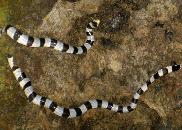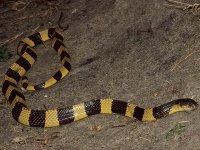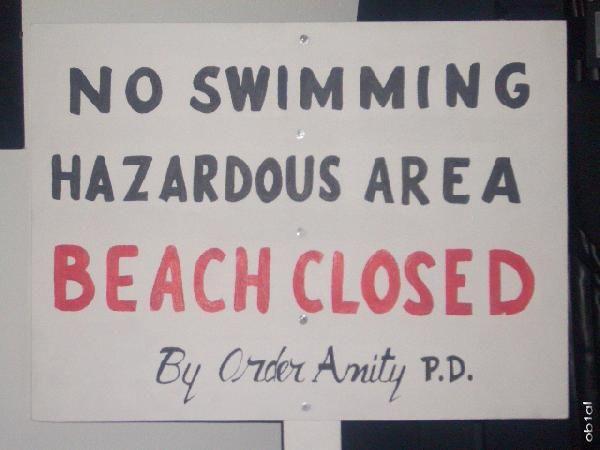Sea Snake Sighting in Paradise
Posted by: Loren Coleman on July 22nd, 2009
What is happening in Bermuda?
Sea snakes are not suppose to be in this little paradise. But has there been a credible sighting in Bermuda of a species similar to the yellow-lipped sea krait, Laticauda colubrina (shown below)? No sea snakes are known to live in the Atlantic Ocean.
The American eyewitness in Bermuda – a police officer – wonders. But the island’s officials are somewhat treating the report like the fictional authorities in the movie Jaws reacted to the first sightings of a shark. They can’t quite make up their minds what to do about it.
The Bermuda Department of Parks and Conservation Services first put out this notice last Friday: “The Department apologises for the inconvenience in this matter but until the species has been identified it was felt that closing the beach was in the interests of public safety. The cooperation of the general public is appreciated at this time.”
But it didn’t last long. Jobson’s Cove, South Shore, Bermuda was reopened on Monday, July 20, 2009, after it was closed on Friday, July 17, due to the possible “sea snake” sighting.
The Department of Parks termed the sighting by a “tourist” of “an unidentified amphibious creature, possibly a snake.”
Due to the fact that no additional sightings of the suspected “snake” were reported, the closed signs were removed from the beach on Monday.

Sea kraits off Fiji, Pacific Ocean.
Meanwhile, at a meeting of experts and the Bermuda media on Tuesday, July 21, 2009, the authorities revealed the animal might be a sea krait – a venomous but non-aggressive reptile. But the tone was carefully skeptical, as the press was told that there “has never been a sighting in Bermuda before.”
But wait a minute. Don’t they mean no “proven” sightings? For guess what one of their experts said?
Dr. Ian Walker, curator at the Bermuda Aquarium, Museum and Zoo, said: “The majority of reported sea snakes in Bermuda are either American eels or some variations of morays. The description the tourist gave was unusual and was enough to raise concerns.”
So, there have been “reported sea snakes” sightings before?
The current eyewitness, who keeps being identified by Bermuda spokespeople as a “tourist,” as previously mentioned, happens to be a U.S. police officer and therefore would seem to be credible in his descriptions.
Oh yes, the witness reportedly took a photograph (unpublished to date?) of the “snake.” But Walker said it is “definitively not a krait.” However, the police officer gave a separate description of an animal at the cove on a different occasion that could be a krait, according to Walker. The policeman claimed the snake he saw was 18-20 inches long with black and white stripes and a yellow head, and climbed a 10 ft cliff.
Walker said: “The public is at very little danger but be cautious. In the case of a bite seek medical attention rapidly.”
No kidding!

Another sea krait from the Pacific.
About Loren Coleman
Loren Coleman is one of the world’s leading cryptozoologists, some say “the” leading living cryptozoologist. Certainly, he is acknowledged as the current living American researcher and writer who has most popularized cryptozoology in the late 20th and early 21st centuries.
Starting his fieldwork and investigations in 1960, after traveling and trekking extensively in pursuit of cryptozoological mysteries, Coleman began writing to share his experiences in 1969. An honorary member of Ivan T. Sanderson’s Society for the Investigation of the Unexplained in the 1970s, Coleman has been bestowed with similar honorary memberships of the North Idaho College Cryptozoology Club in 1983, and in subsequent years, that of the British Columbia Scientific Cryptozoology Club, CryptoSafari International, and other international organizations. He was also a Life Member and Benefactor of the International Society of Cryptozoology (now-defunct).
Loren Coleman’s daily blog, as a member of the Cryptomundo Team, served as an ongoing avenue of communication for the ever-growing body of cryptozoo news from 2005 through 2013. He returned as an infrequent contributor beginning Halloween week of 2015.
Coleman is the founder in 2003, and current director of the International Cryptozoology Museum in Portland, Maine.














Well, they’ll have a job getting the egg off their faces if it turns out the reports are accurate. Hope that picture finds its way to Cryptomundo at some point.
That’s amazing. Out of place snake. WOW. Someone just dropped it off there?
I can’t believe they closed the beach. Sea Snakes are non aggressive. If your going to get bitten by one it’s because you harrassed it to much.
MrsB – Well, that’s exactly the problem – beachgoers have the unfortunate tendency to be nosy gits. If a sea snake showed up, someone would end up doing something stupid.
Sounds like it could be a case of “Irresponsible pet owner with animal that has grown too large deciding to drop the critter off at the nearest beach to have hapless, unsuspecting beachgoers risk being bitten/killed by it” Syndrome. 😉
The police officer looks like a very credible witness—I’d like to see the “photographic evidence” he has, though.
Hopefully no one will be “affected” by this.
Hopefully.
Cryptidsrus – I don’t know of many people that keep sea snakes as pets, to be honest – they generally stay in the ocean, owing to a lack of popularity with people, and the fact that they survive best when left where they survive best.
You’re right, CryptoInformant 2.0. Just remember, though, that some people will choose ANY kind of animal as pet. No matter how “unlikely” that is. Just the other day I heard of a couple (I think it was in England) having a LLAMA as a pet inside their home. There was another one that had a BENGAL TIGER indoors.
I have heard (sorry, can’t recall source) a report of sea snakes gradually moving from the Pacific to the Caribbean/Atlantic through the Panama Canal. The fresh water might represent a barrier but I seem to recall some suggestion that they could cope with it. Just a thought.
Cryptidsrus – Llamas have been domesticated, and it is not all that unlikely for someone to have one as a pet. Big cats, while an unwise choice, have some precedent for being kept as pets as well – neither of the two things you mentioned surprised me. Both species, in fact, have been kept in captivity prior to being kept as pets.
I do not know of any case of a sea krait being kept as a pet, or even in a zoo.
I have heard (sorry, can’t recall source) a report of sea snakes gradually moving from the Pacific to the Caribbean/Atlantic through the Panama Canal. The fresh water might represent a barrier but I seem to recall some suggestion that they could cope with it.
This is from Wikipedia:
Note that the snake mentioned, Pelamis, is a different genus than the sea kraits, Laticauda.
Crazy! Most sea snakes are far from dangerous, although I myself just figured that out =] Recently, I’ve been seeing a lot of a yellow and black variety washing up on my beach. I wrote this post about sea snakes on the beach that explains what I learned about them. They never close the beaches here (Costa Rica) because of it.